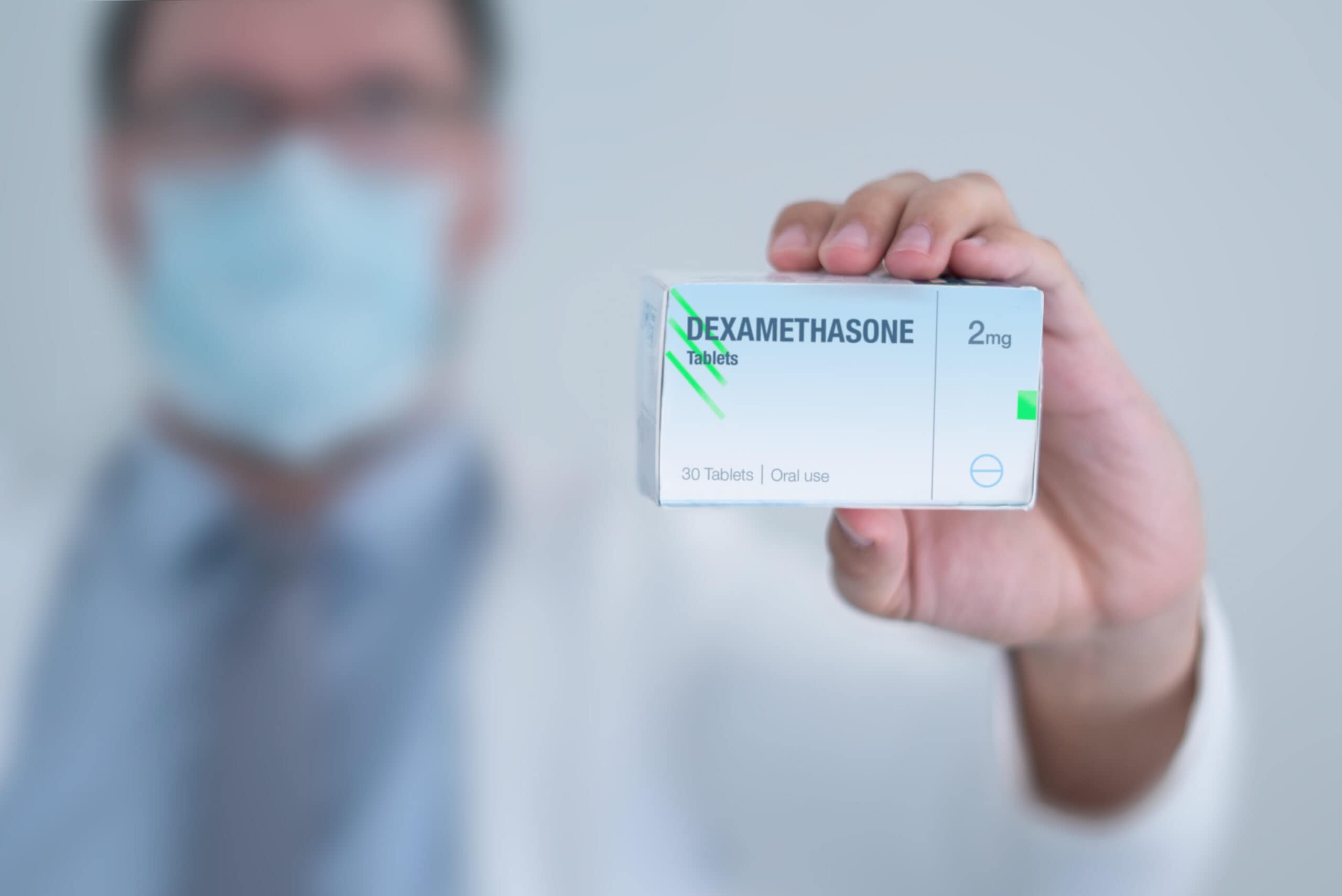When Milligrams Are Toxic: Corticosteroids and Tissue Damage

Many physicians are addicted to using steroids despite research showing they damage orthopedic tissues like joints and tendons. However, this is just a problem of not understanding the proper dose to use, which has been caused by institutional momentum. Let’s dig into how these drugs cause havoc in the body and how they could be used in a way that helps without collateral damage.
Corticosteroid 101
When we hear the term “steroid,” many think about the type of steroids bodybuilders use, called “anabolic steroids”. This type of steroid builds muscle, among other things. However, here we’re discussing “corticosteroids,” which instead act in the body as anti-inflammatories.
If you remember the movie “My Big Fat Greek Wedding,” the father believed Windex cured everything. That’s pretty much modern medicine’s approach to corticosteroids. They are used in everything from knee arthritis to asthma and in many other diseases.
Your doctor calls this a “steroid shot” or “cortisone.” These medications are anti-inflammatories and go by names like Depo-Medrol, betamethasone, dexamethasone, triamcinolone, methylprednisolone, Celestone, and Kenalog.
These Medications are Tissue Toxic
One of the things that will really piss off certain physicians who use steroids every day in their practices is the discussion that since the 1950s, we’ve had mounting evidence that injecting corticosteroids into joints or tendons is a bad idea. In addition, as this evidence has built upon itself, about five years ago, the evidence became overwhelming that using these drugs in this way is harming patients. So what do we know?
The first paper on steroid shot side effects was in 1951! (7) Others followed that research in the 60s and then a parade of animal studies showing that steroid shots hurt cartilage cells in joints, (9,11) If there was any doubt left that steroids hurt joints, recently a randomized controlled trial in real patients with knee arthritis showed that patients who got steroid shots for knee arthritis not only showed no improvement over saline injections, but they also had an accelerated loss of cartilage (1).
How bad are steroids for knee joints? In one recent study, the authors looked at almost four thousand patients who were part of a government-funded arthritis study (15). Each steroid shot in the knee increased the likelihood of needing a knee replacement by 9%. Meaning if you got 4 steroid shots to help arthritis pain, this increased the likelihood that you needed a knee replacement by about 36%!
We’ve also known for quite some time that patients who get steroid shots for various types of joint pain or arthritis are at higher risk for infection if they get a joint replacement at some point down the road (3). This is a thing not only for knees but also for hips as well (5). The research also supports that getting a steroid shot to help knee arthritis pain can increase the likelihood of needing a knee replacement, meaning the shot causes more knee cartilage breakdown (2). Hence, steroid shot side effects include increasing the risk of a joint replacement complication or needing one in the first place.
We’ve known for a while that steroid shot side effects extend into the area of tendon healing. For example, in one study measuring the healing blood vessels that grow into shoulder rotator cuff tears, patients who had steroid shots had fewer new blood vessels (10). In another, the medication injured tendon cells in patients getting steroid shots (13). In a more recent large review, steroid shot side effects in patients undergoing rotator cuff repair included higher retear rates (when the rotator cuff surgery fails) and the need for another surgery (14).
We also know that these injections have systemic or whole-body effects. For example, one study demonstrated that steroids used in epidural injections for back pain worsened osteoporosis in women (4). The same type of steroid shots also mess with the cortisol endocrine system that helps to keep you healthy (6). Finally, getting your knee joint injected also causes dysregulation of your blood sugar, causing it to increase (12).
Can Lowering the Dose Help?
Interestingly, the steroid problem seems to be a simple dosing issue. These medications are traditionally made in milligram ranges. This sounds like such a small amount, but when you consider that the body excetes and uses corticosteroids in the nanogram dose range, milligrams become a huge problem (17). Let’s visually compare these two doses:

The nanogram is off to the right above. Despite my blowing up the scale of the graph, you still can’t quite see it compared to the milligram, but it’s 1 million times less of a dose.
We’ve used nanogram dose steroids for almost two decades in the clinic. They work as well to modulate out-of-control inflammation but don’t destroy tissues. You must get these drugs specially compounded by a pharmacy as you can’t buy them at a medical supply company in this dose range.
Why are Milligram Dose Steroids Destroying Tissue?
Researchers from McGill University recently published in the medical journal Science Translational Medicine looking at how chronic pain takes hold in both mice and humans (16). The team determined that what separates patients whose pain resolves quickly from those who develop chronic pain is how their bodies use a key inflammatory cell called neutrophils. Experimentally blocking neutrophils in mice with an acute injury prolonged their pain by up to ten times the normal duration. Treating those same animals with mega-dose steroids or NSAIDs produced the same result. These findings were also supported by an analysis of 500,000 people in the UK which showed that those taking NSAIDs for pain were more likely to develop chronic pain 2-10 years later. This effect wasn’t seen in patients taking Tylenol.
Recommendations
We already have high-quality clinical RCT research that shows that platelet-rich plasma works better than corticosteroids (18,19). In addition, the basic science research on PRP shows none of these cartilage or tendon toxic side effects. Meaning that PRP helps healing and doesn’t block it. Hence, refuse that steroid shot the doctor wants to inject into your knee or shoulder and seek a PRP injection instead! Also, if you want to modulate inflammation using a corticosteroid, your doctor can get steroids compounded at a pharmacy in the nanogram dose range, which your body is used to.
The upshot? Corticosteroid injections are bad news! Please avoid these injections and spread the word to your friends and family. Your joints and tendons will thank you.
_____________________________________________________
References:
(1) McAlindon TE, LaValley MP, Harvey WF, et al. Effect of Intra-articular Triamcinolone vs Saline on Knee Cartilage Volume and Pain in Patients With Knee Osteoarthritis: A Randomized Clinical Trial. JAMA.2017;317(19):1967–1975. doi: 10.1001/jama.2017.5283
(2) Wijn SRW, Rovers MM, van Tienen TG, Hannink G. Intra-articular corticosteroid injections increase the risk of requiring knee arthroplasty. Bone Joint J. 2020 May;102-B(5):586-592. doi: 10.1302/0301-620X.
(3) Richardson SS, Schairer WW, Sculco TP, Sculco PK. Comparison of Infection Risk with Corticosteroid or Hyaluronic Acid Injection Prior to Total Knee Arthroplasty. J Bone Joint Surg Am. 2019 Jan 16;101(2):112-118. doi: 10.2106/JBJS.18.00454.
(4) Kang SS, Hwang BM, Son H, Cheong IY, Lee SJ, Chung TY. Changes in bone mineral density in postmenopausal women treated with epidural steroid injections for lower back pain. Pain Physician. 2012 May-Jun;15(3):229-36.
(5) Ravi B, Escott BG, Wasserstein D, Croxford R, Hollands S, Paterson JM, Kreder HJ, Hawker GA. Intraarticular hip injection and early revision surgery following total hip arthroplasty: a retrospective cohort study. Arthritis Rheumatol. 2015 Jan;67(1):162-8. doi: 10.1002/art.38886.
(6) Chon JY, Moon HS. Salivary cortisol concentration changes after epidural steroid injection. Pain Physician. 2012 Nov-Dec;15(6):461-6.
(7) STEINBROCKER O, EHRLICH ME, SILVER M, SICHER W, BERKOWITZ S, CARP S, FEISTEIN H. The clinical application of cortisone and ACTH in arthritis and related conditions: methods and problems. II: Side effects complications, contraindications, precautions and conclusions. Ariz Med. 1951 Sep;8(9):29-35.
(8) Brånemark PI, Goldie I. Observations on the action of prednisolone tertiary buryl acetate (Codelcortone TBA) and methylprednisolone acetate (depomedrone) on normal soft tissues. Acta Rheumatol Scand. 1967;13(4):241-56.
(9) Wang BL, Sun W, Shi ZC, et al. Decreased proliferation of mesenchymal stem cells in corticosteroid-induced osteonecrosis of femoral head. Orthopedics. 2008;31(5):444. doi:10.3928/01477447-20080501-33
(10) Bonnevialle N, Bayle X, Projetti F, Wargny M, Gomez-Brouchet A, Mansat P. Variations of the micro-vascularization of the greater tuberosity in patients with rotator cuff tears. Int Orthop. 2015;39(2):371‐376. doi:10.1007/s00264-014-2628-z
(11) Murray RC, DeBowes RM, Gaughan EM, Zhu CF, Athanasiou KA. The effects of intra-articular methylprednisolone and exercise on the mechanical properties of articular cartilage in the horse. Osteoarthritis Cartilage. 1998;6(2):106‐114. doi:10.1053/joca.1997.0100
(12) Habib GS. Systemic effects of intra-articular corticosteroids. Clin Rheumatol. 2009;28(7):749‐756. doi:10.1007/s10067-009-1135-x
(13) Dean BJ, Franklin SL, Murphy RJ, Javaid MK, Carr AJ. Glucocorticoids induce specific ion-channel-mediated toxicity in human rotator cuff tendon: a mechanism underpinning the ultimately deleterious effect of steroid injection in tendinopathy?. Br J Sports Med. 2014;48(22):1620‐1626. doi:10.1136/bjsports-2013-093178
(14) Cimino AM, Veazey GC, McMurtrie JT, et al. The Effect of Corticosteroid Injections on Clinical Outcomes and Failure Rates after Rotator Cuff Repair: A Systematic Review [published online ahead of print, 2020 May 7]. Arthroscopy. 2020;S0749-8063(20)30379-0. doi:10.1016/j.arthro.2020.04.044
(15) Wijn SRW, Rovers MM, van Tienen TG, Hannink G. Intra-articular corticosteroid injections increase the risk of requiring knee arthroplasty. Bone Joint J. 2020;102-B(5):586‐592. doi:10.1302/0301-620X.102B5.BJJ-2019-1376.R1
(16) Parisien M, Lima LV, Dagostino C, El-Hachem N, Drury GL, Grant AV, Huising J, Verma V, Meloto CB, Silva JR, Dutra GGS, Markova T, Dang H, Tessier PA, Slade GD, Nackley AG, Ghasemlou N, Mogil JS, Allegri M, Diatchenko L. Acute inflammatory response via neutrophil activation protects against the development of chronic pain. Sci Transl Med. 2022 May 11;14(644):eabj9954. doi: 10.1126/scitranslmed.abj9954. Epub 2022 May 11. PMID: 35544595.
(17) Mushtaq T, Farquharson C, Seawright E, Ahmed SF. Glucocorticoid effects on chondrogenesis, differentiation and apoptosis in the murine ATDC5 chondrocyte cell line. J Endocrinol. 2002 Dec;175(3):705-13. doi: 10.1677/joe.0.1750705. PMID: 12475381.
(18) Uslu Güvendi E, Aşkin A, Güvendi G, Koçyiğit H. Comparison of Efficiency Between Corticosteroid and Platelet Rich Plasma Injection Therapies in Patients With Knee Osteoarthritis. Arch Rheumatol. 2017;33(3):273–281. Published 2017 Nov 2. doi: 10.5606/ArchRheumatol.2018.6608
(19) Huang Y, Liu X, Xu X, Liu J. Intra-articular injections of platelet-rich plasma, hyaluronic acid or corticosteroids for knee osteoarthritis : A prospective randomized controlled study. Orthopade. 2019 Mar;48(3):239-247. doi: 10.1007/s00132-018-03659-5.

NOTE: This blog post provides general information to help the reader better understand regenerative medicine, musculoskeletal health, and related subjects. All content provided in this blog, website, or any linked materials, including text, graphics, images, patient profiles, outcomes, and information, are not intended and should not be considered or used as a substitute for medical advice, diagnosis, or treatment. Please always consult with a professional and certified healthcare provider to discuss if a treatment is right for you.
